 The stirrers that mix cream into your coffee probably don?t make much difference to the drink. But in a chemistry lab, it turns out using the wrong stirrer can skew the science.
The stirrers that mix cream into your coffee probably don?t make much difference to the drink. But in a chemistry lab, it turns out using the wrong stirrer can skew the science.
Friday, March 29, 2019
Odd reaction when functionalizing nanotubes creates a stir in the lab
 The stirrers that mix cream into your coffee probably don?t make much difference to the drink. But in a chemistry lab, it turns out using the wrong stirrer can skew the science.
The stirrers that mix cream into your coffee probably don?t make much difference to the drink. But in a chemistry lab, it turns out using the wrong stirrer can skew the science.
Just add heat to open this tiny box: Nanocubes automatically connect, disassemble at different temperatures
 Researchers have designed two types of nano-sized building blocks that can automatically connect into cubes and scramble back into individual components based on the temperature of their environment. This accomplishment is another step towards chemical systems that more realistically mimic life.
Researchers have designed two types of nano-sized building blocks that can automatically connect into cubes and scramble back into individual components based on the temperature of their environment. This accomplishment is another step towards chemical systems that more realistically mimic life.
Quantum physics and origami for the ultimate get-well card
 Scientists have combined the simplicity of paper with the complexity of quantum physics for point-of-care testing in low-resource environments.
Scientists have combined the simplicity of paper with the complexity of quantum physics for point-of-care testing in low-resource environments.
Thursday, March 28, 2019
Illuminating water filtration
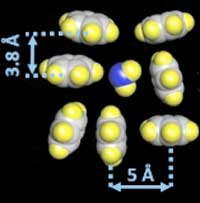 Researchers using ultrabright x-rays reveal the molecular structure of membranes used to purify seawater into drinking water.
Researchers using ultrabright x-rays reveal the molecular structure of membranes used to purify seawater into drinking water.
Tiny optical elements could one day replace traditional refractive lenses
 A research team has developed tiny optical elements from metal nanoparticles and a polymer that one day could replace traditional refractive lenses to realize portable imaging systems and optoelectronic devices.
A research team has developed tiny optical elements from metal nanoparticles and a polymer that one day could replace traditional refractive lenses to realize portable imaging systems and optoelectronic devices.
A nanomagnet compass pointing West
 Scientists have discovered a special phenomenon in magnets. This phenomenon takes place at the nanoscale and enables magnets to be assembled in unusual configurations, which could also be useful for computer technology and data storage.
Scientists have discovered a special phenomenon in magnets. This phenomenon takes place at the nanoscale and enables magnets to be assembled in unusual configurations, which could also be useful for computer technology and data storage.
Ferromagnetic nanoparticle systems show promise for ultrahigh-speed spintronics
 In the future, ultrahigh-speed spintronics will require ultrafast coherent magnetization reversal within a picosecond - one-trillionth of a second. Spintronics centers on an electron's spin and magnetic moment in solid-state devices.
In the future, ultrahigh-speed spintronics will require ultrafast coherent magnetization reversal within a picosecond - one-trillionth of a second. Spintronics centers on an electron's spin and magnetic moment in solid-state devices.
Tomorrow's data memories: Using new technology to explore single molecule magnets in slow motion
 Similar to slow motion, details about single molecule magnets can now be analysed in a complementary way in order to find out more about their storage capacity.
Similar to slow motion, details about single molecule magnets can now be analysed in a complementary way in order to find out more about their storage capacity.
Nanovaccine boosts immunity in sufferers of metabolic syndrome
 A new class of biomaterial for an infectious disease nanovaccine effectively boosted immunity in mice with metabolic disorders linked to gut bacteria - a population that shows resistance to traditional flu and polio vaccines.
A new class of biomaterial for an infectious disease nanovaccine effectively boosted immunity in mice with metabolic disorders linked to gut bacteria - a population that shows resistance to traditional flu and polio vaccines.
'Biological bandage' could help heal wounds
 Scientists have developed a three-dimensional protein structure in the laboratory that could help to heal wounds in the future. It is conceivable that one day this network could be produced as a kind of 'biological bandage' from the blood of the person who will use it.
Scientists have developed a three-dimensional protein structure in the laboratory that could help to heal wounds in the future. It is conceivable that one day this network could be produced as a kind of 'biological bandage' from the blood of the person who will use it.
Fullerenes Bridge conductive gap in organic photovoltaics
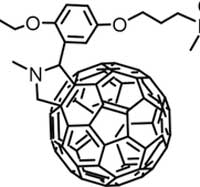 Efficient cathode interlayers made of ionene polymers refined with pendant fullerenes.
Efficient cathode interlayers made of ionene polymers refined with pendant fullerenes.
The latest nanotechnology books
 Here are some interesting books on nanotechnology topics that just got published.
Here are some interesting books on nanotechnology topics that just got published.
Wednesday, March 27, 2019
Researchers generate ultra-short spin waves in an astoundingly simple material
 Researchers have successfully generated so-called spin waves much more easily and efficiently than was previously deemed possible.
Researchers have successfully generated so-called spin waves much more easily and efficiently than was previously deemed possible.
Lipid vesicles transmit luminous or electrical signals
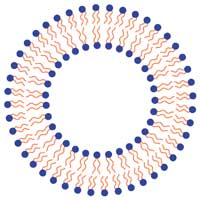 Fluorescent molecules or charges enable liposomes to transmit light or electrical signals. Magnetic particles added to the material allow transmission to be controlled by means of magnets.
Fluorescent molecules or charges enable liposomes to transmit light or electrical signals. Magnetic particles added to the material allow transmission to be controlled by means of magnets.
Fabrication of lightweight, flaw-tolerant and ultrastrong nanoarchitected carbon
 Researchers report the fabrication and mechanical behaviors of lightweight and ultra-strong pyrolytic carbon nanolattices which are insensitive to fabrication-induced defects.
Researchers report the fabrication and mechanical behaviors of lightweight and ultra-strong pyrolytic carbon nanolattices which are insensitive to fabrication-induced defects.
Engineers craft the basic building block for electrospun nanofibers
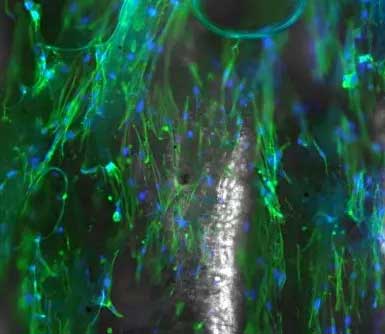 Scientists came up with a new way to create customizable nanofibers for growing cell cultures that cuts out time spent removing toxic solvents and chemicals.
Scientists came up with a new way to create customizable nanofibers for growing cell cultures that cuts out time spent removing toxic solvents and chemicals.
Unique electrostatically charged nanofiber with enhanced performance in filtering airborne pollutants and viruses
 Researchers developed an electrostatically charged nanofiber filter with multiple separator layers, which can capture pollutant particles that are below 100 nm in diameter. The novel nanofiber filter demonstrates better performance in terms of breathability, filtration efficiency, and shelf life.
Researchers developed an electrostatically charged nanofiber filter with multiple separator layers, which can capture pollutant particles that are below 100 nm in diameter. The novel nanofiber filter demonstrates better performance in terms of breathability, filtration efficiency, and shelf life.
New research explores graphene-silicon devices for photonics applications
 Researchers have engineered a silicon-graphene device that can transmit radiofrequency waves in less than a picosecond at a sub-terahertz bandwidth.
Researchers have engineered a silicon-graphene device that can transmit radiofrequency waves in less than a picosecond at a sub-terahertz bandwidth.
New software automates design of optical metamaterials (w/video)
 New software lets users design science-fiction-like materials with the same efficiency that architects draft building plans.
New software lets users design science-fiction-like materials with the same efficiency that architects draft building plans.
Tuesday, March 26, 2019
A new spin on organic semiconductors
 Researchers have found that certain organic semiconducting materials can transport spin faster than they conduct charge, a phenomenon which could eventually power faster, more energy-efficient computers.
Researchers have found that certain organic semiconducting materials can transport spin faster than they conduct charge, a phenomenon which could eventually power faster, more energy-efficient computers.
Bacteria could become a future source of electricity
 In recent years, researchers have tried to capture the electrical current that bacteria generate through their own metabolism. So far, however, the transfer of the current from the bacteria to a receiving electrode has not been efficient at all. Now, they have achieved a slightly more efficient transfer of electrical current.
In recent years, researchers have tried to capture the electrical current that bacteria generate through their own metabolism. So far, however, the transfer of the current from the bacteria to a receiving electrode has not been efficient at all. Now, they have achieved a slightly more efficient transfer of electrical current.
Layered liquids arrange nanoparticles into useful configurations
 Theoretical approach for assembling nanoparticles uses an idea similar to separated vinaigrettes.
Theoretical approach for assembling nanoparticles uses an idea similar to separated vinaigrettes.
Brightening perovskite LEDs with photonic crystals
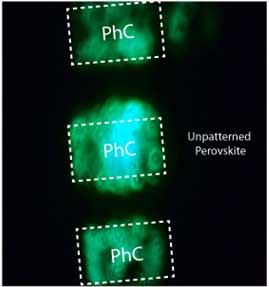 Researchers demonstrated high light extraction efficiency of perovskite photonic crystals fabricated by delicate electron-beam lithography.
Researchers demonstrated high light extraction efficiency of perovskite photonic crystals fabricated by delicate electron-beam lithography.
Electronics at the nanoscale: challenges and opportunities for making metal nanowires
 Molecular nanowires can be used for many applications, from LED lights to medical devices.
Molecular nanowires can be used for many applications, from LED lights to medical devices.
Metal nanoclusters can be used as semiconductors: key properties observed for first time
 Tiny nanoclusters of metal atoms - such as gold and silver - have properties, which mean they can be used as semiconductors. The finding opens the door to a wide range of potential new applications, from phone displays and flatter screens to wearable technology.
Tiny nanoclusters of metal atoms - such as gold and silver - have properties, which mean they can be used as semiconductors. The finding opens the door to a wide range of potential new applications, from phone displays and flatter screens to wearable technology.
Will cyborg circuits be made of melanin?
 Scientists have achieved a billion-fold increase in the electrical conductivity of melanin, that could unleash its potential in safe, sustainable bioelectronics.
Scientists have achieved a billion-fold increase in the electrical conductivity of melanin, that could unleash its potential in safe, sustainable bioelectronics.
Do nanomaterials affect pollinating insects?
 There is concern that pollinating insects are at risk due to nanomaterial exposure. Pollinating insects like bees or bumblebees are potentially exposed to nanomaterials via aerosols, the pollen of contaminated plants and water droplets. Managed pollinators may be additionally exposed in the hives due to direct application of nanomaterials by beekeepers.
There is concern that pollinating insects are at risk due to nanomaterial exposure. Pollinating insects like bees or bumblebees are potentially exposed to nanomaterials via aerosols, the pollen of contaminated plants and water droplets. Managed pollinators may be additionally exposed in the hives due to direct application of nanomaterials by beekeepers.
Monday, March 25, 2019
Engineering cellular function without living cells
 Scientists have come up with a systematic method for studying and even predicting gene expression - without using cells. Using their innovative, quantitative approach, they measured important parameters governing gene regulation. This allowed them to design and construct a synthetic biological logic gate, which could one day be used to introduce new functions into cells.
Scientists have come up with a systematic method for studying and even predicting gene expression - without using cells. Using their innovative, quantitative approach, they measured important parameters governing gene regulation. This allowed them to design and construct a synthetic biological logic gate, which could one day be used to introduce new functions into cells.
Cellulose nanofiber hydrogel for enhanced cell encapsulation and delivery
 Cellulose nanofibers hydrogel has great potential as a cell-encapsulation delivery carrier for sustained release of paracrine factors and for tissue regeneration, with unique versatility for injection, scaffolding, and 3D bioprinting.
Cellulose nanofibers hydrogel has great potential as a cell-encapsulation delivery carrier for sustained release of paracrine factors and for tissue regeneration, with unique versatility for injection, scaffolding, and 3D bioprinting.
Nanocellulose-based material gives three sensors in one
 Cellulose soaked in a carefully designed polymer mixture acts as a sensor to measure pressure, temperature and humidity -- at the same time. The measurements are completely independent of each other. The sensor may be highly significant in fields such as robotics, healthcare and security.
Cellulose soaked in a carefully designed polymer mixture acts as a sensor to measure pressure, temperature and humidity -- at the same time. The measurements are completely independent of each other. The sensor may be highly significant in fields such as robotics, healthcare and security.
Physicists shatter Bose-Einstein condensate, get different pieces every time
 Physicists have shown that shaking ultracold Bose-Einstein condensates can cause them to either divide into uniform segments or shatter into unpredictable splinters, depending on the frequency of the shaking.
Physicists have shown that shaking ultracold Bose-Einstein condensates can cause them to either divide into uniform segments or shatter into unpredictable splinters, depending on the frequency of the shaking.
Extremely accurate measurements of atom states for quantum computing
 A new method allows the quantum state of atomic qubits to be measured with twenty times less error than was previously possible, without losing any atoms.
A new method allows the quantum state of atomic qubits to be measured with twenty times less error than was previously possible, without losing any atoms.
Wood-based technology creates electricity from heat
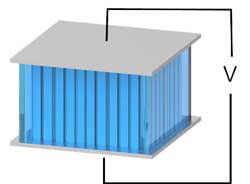 Researchers have created a heat-to-electricity device that runs on ions and which could someday harness the body?s heat to provide energy.
Researchers have created a heat-to-electricity device that runs on ions and which could someday harness the body?s heat to provide energy.
Gold soaks up boron, spits out borophene
 In the heat of a furnace, boron atoms happily dive into a bath of gold. And when things get cool, they resurface as coveted borophene.
In the heat of a furnace, boron atoms happily dive into a bath of gold. And when things get cool, they resurface as coveted borophene.
Optimizing the energy production of photovoltaic panels using artificial intelligence
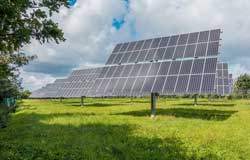 Researchers have developed a method based on artificial intelligence techniques that consider the atmospheric variations when designing the solar cells to produce more energy.
Researchers have developed a method based on artificial intelligence techniques that consider the atmospheric variations when designing the solar cells to produce more energy.
Scientists squeeze catalysts inside host materials like a ship into a bottle
 Scientists have found a way to place catalysts inside the tiniest pores of different host materials, a bit like when model ships are unfolded inside a bottle.
Scientists have found a way to place catalysts inside the tiniest pores of different host materials, a bit like when model ships are unfolded inside a bottle.
Saturday, March 23, 2019
Breakthrough in air purification with a catalyst that works at room temperature
 Turning ammonia into harmless substances using gold nanoparticles on a metal oxide framework.
Turning ammonia into harmless substances using gold nanoparticles on a metal oxide framework.
Friday, March 22, 2019
Molecular modeling may accelerate the development of new organic materials for electronics
 Scientists have developed a faster way of creating molecular models by using machine learning. The new models dramatically accelerate the screening of potential new organic materials for electronics and they could also be useful in other areas of materials science research.
Scientists have developed a faster way of creating molecular models by using machine learning. The new models dramatically accelerate the screening of potential new organic materials for electronics and they could also be useful in other areas of materials science research.
Chemicals induce dipoles to damp plasmons
 A study finds that molecules alter gold nanoparticles' electronic properties.
A study finds that molecules alter gold nanoparticles' electronic properties.
Optical tweezers combine with X-rays to enable analysis of crystals in liquids
 Scientists have developed a new technique that combines the power of nanoscale 'tractor beams' with high-powered X-rays, enabling them to position and manipulate crystals in solution that are not in contact with substrates.
Scientists have developed a new technique that combines the power of nanoscale 'tractor beams' with high-powered X-rays, enabling them to position and manipulate crystals in solution that are not in contact with substrates.
4D-printed materials can be stiff as wood or soft as sponge
 Engineers' unique smart materials change shape as temperatures change.
Engineers' unique smart materials change shape as temperatures change.
Thursday, March 21, 2019
Nanomembrane could help regrow tissue lost to periodontal disease
 Researchers report development of a membrane that helps periodontal tissue regenerate when implanted into the gums of rats.
Researchers report development of a membrane that helps periodontal tissue regenerate when implanted into the gums of rats.
Making solar cells is like buttering bread
 Formamidinium lead iodide is a very good material for photovoltaic cells, but getting the correct and stable crystal structure is a challenge. The techniques developed so far have produced rather poor results. Researchers have now cracked it - using a blade and a dipping solution.
Formamidinium lead iodide is a very good material for photovoltaic cells, but getting the correct and stable crystal structure is a challenge. The techniques developed so far have produced rather poor results. Researchers have now cracked it - using a blade and a dipping solution.
Nanotechnology approach may lead to precision-based strategy for triple negative breast cancer
 Researchers recently reported several important findings related to triple negative breast cancer and its future treatment.
Researchers recently reported several important findings related to triple negative breast cancer and its future treatment.
In a new quantum simulator, light behaves like a magnet
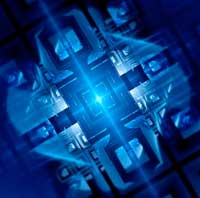 Physicists propose a new 'quantum simulator': a laser-based device that can be used to study a wide range of quantum systems. Studying it, the researchers have found that photons can behave like magnetic dipoles at temperatures close to absolute zero, following the laws of quantum mechanics. The simple simulator can be used to better understand the properties of complex materials under such extreme conditions.
Physicists propose a new 'quantum simulator': a laser-based device that can be used to study a wide range of quantum systems. Studying it, the researchers have found that photons can behave like magnetic dipoles at temperatures close to absolute zero, following the laws of quantum mechanics. The simple simulator can be used to better understand the properties of complex materials under such extreme conditions.
Engineers demonstrate metamaterials that can solve equations
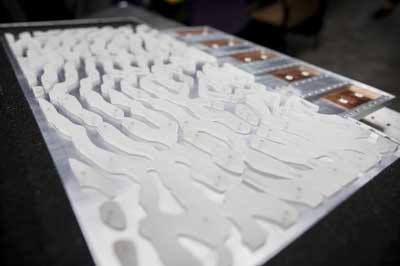 This 'photonic calculus' would work by encoding parameters into the properties of an incoming electromagnetic wave and sending it through a metamaterial device; once inside, the device's unique structure would manipulate the wave in such a way that it would exit encoded with the solution to a pre-set integral equation for that arbitrary input.
This 'photonic calculus' would work by encoding parameters into the properties of an incoming electromagnetic wave and sending it through a metamaterial device; once inside, the device's unique structure would manipulate the wave in such a way that it would exit encoded with the solution to a pre-set integral equation for that arbitrary input.
Magnetic micro-boats
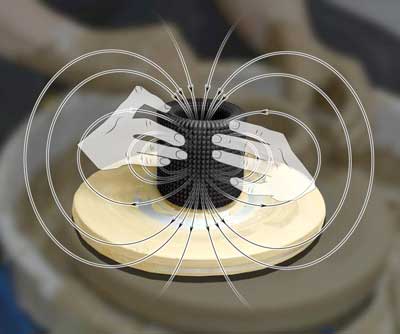 Researchers have created magnetic microparticles, with a newly developed method, that could pave the way for building micro-motors or guiding drugs in the human body to a target, like a tumor. The preparation of such structures as well as their remote-control can be regulated using magnetic fields and therefore can find application in an array of domains.
Researchers have created magnetic microparticles, with a newly developed method, that could pave the way for building micro-motors or guiding drugs in the human body to a target, like a tumor. The preparation of such structures as well as their remote-control can be regulated using magnetic fields and therefore can find application in an array of domains.
Materials could delay frost up to 300 times longer than existing anti-icing coatings
 Scientists describe for the first time several unique properties of materials known as phase-switching liquids, or PSLs, that hold promise as next-generation anti-icing materials. PSLs can delay ice and frost formation up to 300 times longer than state-of-the-art coatings being developed in laboratories.
Scientists describe for the first time several unique properties of materials known as phase-switching liquids, or PSLs, that hold promise as next-generation anti-icing materials. PSLs can delay ice and frost formation up to 300 times longer than state-of-the-art coatings being developed in laboratories.
Golden ball in a golden cage
 'Golden fullerene': ligand-protected nanocluster made of 32 gold atoms.
'Golden fullerene': ligand-protected nanocluster made of 32 gold atoms.
Researchers boost intensity of nanowire LEDs
 Nanowire specialists have made ultraviolet light-emitting diodes (LEDs) that, thanks to a special type of shell, produce five times higher light intensity than do comparable LEDs based on a simpler shell design.
Nanowire specialists have made ultraviolet light-emitting diodes (LEDs) that, thanks to a special type of shell, produce five times higher light intensity than do comparable LEDs based on a simpler shell design.
Subscribe to:
Comments (Atom)
